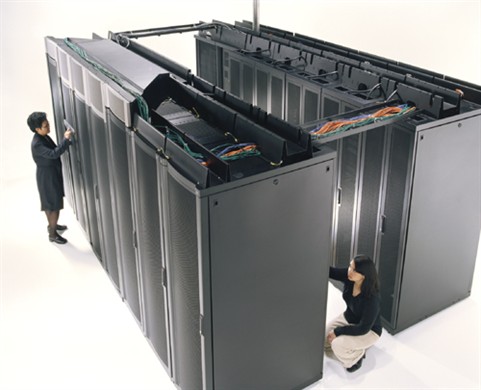As more companies begin installing high density servers, such as blade servers to support their virtualization efforts, it is becoming apparent that an important issue must be addressed. That issue is power consumption and server cooling needs for the more powerful servers which generate more heat.
The average enclosed data center would consume about 1.7 kW. If, however, you are filling that same rack with high density servers, you could expect to be consuming 20 kW. This is over ten times the current power consumption per rack. In most cases these type of loads would exceed the cooling abilities and the power consumption capabilities of an average data center.
This is serious when you consider that most data center operators have no experience with handling loads pulling more than 10 kW.

The answer may seem simple, provide more cooling, but in practice this is not so easily achieved. Here are, however, a few ways to keep high density computing within a data center supplied with adequate power and cooling capabilities.
1. Load Spreading
Load spreading is the simple practice, as the name implies, of spreading out your 1U servers or the newer blade servers out over several racks from Rack Solutions. When servers are installed and spaced closely to one another the heat being generated is multiplied. To make this strategy work you will need to make sure that one single rack does not exceed the rack power density intended for that particular room’s cooling system.
It should also be noted that if you use this technique, which will leave vertical space unused in the racks, you will need to fill that space with blanking panels to avoid negative effects on the cooling performance of your system. Companies are sometimes hesitant to use this technique because it would incorporate more cooling racks, while wasting space in existing ones.
However, this technique is still far more cost effective than attempting to upgrade cooling systems that could handle the new high density servers.
2. Supplemental Cooling
This may seem slightly old fashioned, but it can get the job done, especially if you are not dealing with massive amounts of equipment. Using supplemental cooling systems generally work well with racks that have a density which exceeds the design value for the room cooling system.
3. Dedicated high-density Spots
If there are areas in a room which has particularly high cooling capacity, you can designated this area and then limit your high density enclosures there. This will take some strategic planning and a well-informed knowledge of which racks contain a high density enclosure. You will also need to be able to completely segregate the high density enclosures into that area. Because of the many constraints, most users will not be able to utilize this method, but it is a possible solution.
4. Entire Room Cooling
Another option is to simply provide the room with enough cooling power for any and every rack to its peak of enclosure density. Sounds simple, but this method is rarely used due to the fact that there is so much variation between per rack, and most users rationalize that this will, overall, be a huge waste of money and energy to cool the entire room for the sake of “some” of the higher density racks.
For most users, option number one has proven to be the most cost effective and safest route. Spread out your high density servers over multiple racks, using blanking panels to cover the empty space.
+Katrina specializes in products for the leading custom design and manufacturing of racking products for your tech needs at RackSolutions.com

